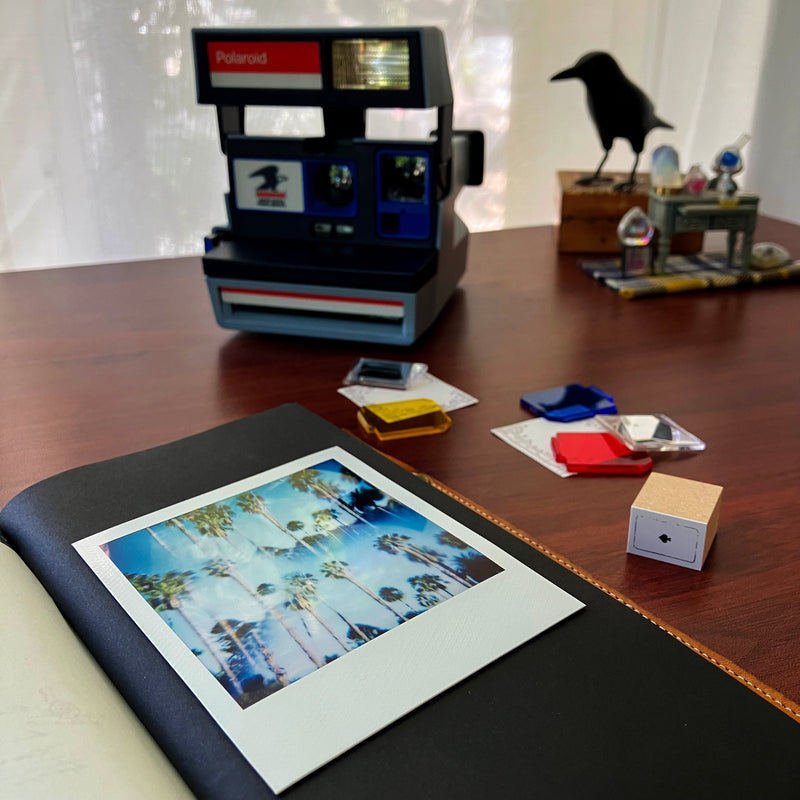It’s been a few years since I got an instant film camera. By now, its photos have almost completely filled an old, square, handmade album, bound with cord, one of the last gifts I ever received from my grandfather in the Philippines. Recently, however, I took some pictures that don’t quite seem to fit on those sturdy brown pages. At first glance, I figured it’s because they’re abstract shots, mainly an excuse to try out a handful of analog filters: red, yellow, blue and fractal ones that split the image into twinned halves and thirds. For a while I kept these experiments in a stack, shuffling them from one corner of my desk to another.

Then I remembered a TN insert, picked up on a whim at a pen show a couple years ago. The enigmatic black paper had instantly appealed to me, though I’d no clear idea of how I wanted to use it. Only vague notions involving opaque ink, gel pens, ghostly layers of stamps. I may still do all that eventually. Once I placed the Polaroids inside, though, they seemed right at home. For now, I think the stark simplicity of one white-framed square on each page is the exact kind of stillness I need.




It’s been a rough year. I won’t get too particular. It’s just that I’ve come to understand the usefulness of a phrase like “taking it day by day” as a shorthand for describing weeks and months slipping by in a haze of helplessness, numbness, insecurity and fear, shot through with sudden illness and loss. The photos in this notebook were taken at times when I was deliberately removing myself from that miasma, forcing myself to walk away from it. Knowing that true escape from these painful struggles is impossible or unacceptable, let it be enough simply to look at something else for a while.
There, then, is the real reason these photos don’t belong with the rest in the album. Unlike the others, they were not taken to capture memories. They’re about release. About allowing the branches, windows, shadows and blooms I see to mean nothing in particular, relieving them of the burden of describing or memorializing any particular event or point in time. I am exercising, or retraining, a tired eye, a sluggish heart. Can I still see what’s in front of me? Do I still remember how to gaze beyond the edges of the frame to decide where to place it? If I cast the world in a different color, does the world actually change? No. Only my perception of it. Which is to say, yes. I’ve stamped this notebook with the name of “darkroom”, and the reasons would seem self-evident: it’s black. I’m putting film photos in it. Simple enough! But it also represents an attempt to embrace the idea that loss and growth, renewal and decay, are both happening at once—even when I cannot see the chemistry at work, much less control it.



In these adverse days, I admit, many of my long-established writing habits are going stale. The daily thoughts stirred up in my stream-of-consciousness writing become circular, mundane or negative; decorating my weekly pages, though still enjoyable and relaxing, brings only a meager spark of joy that quickly sputters out. If playing with stationery is like eating sugar-coated candy, then I still enjoy the flavor, but the sweetness gets overpowered by the slightest artificiality. What to do about this bitter aftertaste? It’s not as if I want to stop keeping my notebooks altogether. But I suspect that it’s time again to let go of how I thought my creativity was supposed to serve me. Unclench an anxious grasp on the way I imagined life was supposed to look like by now. And trust that a new picture will reveal itself over time, slowly, in the dark.

___
Text and photos by: A.C. Esguerra
Where to find A.C. : IG @blueludebar
Read other stories by A.C. : Here


Your words are beautiful, A.C. They struck a chord in my heart, especially, “Knowing that true escape from these painful struggles is impossible or unacceptable, let it be enough simply to look at something else for a while.” Thank you for sharing this with us.